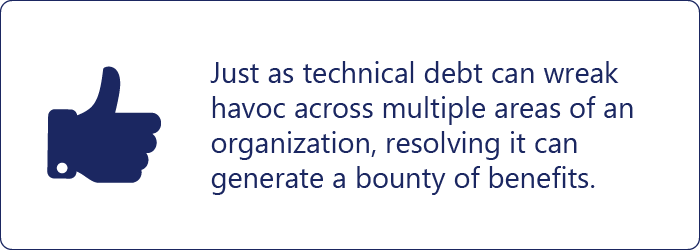5-minute read
Quick summary: The Great Resignation has underscored the impact that technical debt can have on the ability to respond quickly to business drivers.
In 2021, an average of 3.95 million U.S. workers quit their jobs each month—a record-breaking high. While opinions vary about the exact causes of the “Great Resignation,” the impact of this sudden, colossal shift in the workforce continues to have far-reaching implications. If you’re wondering what it has to do with technical debt, here’s the answer: plenty.
When workers leave, the knowledge they’ve acquired during their tenures goes with them—including knowledge that has enabled tech debt–laden systems to continue functioning (for better or for worse … usually worse). We’re not just talking about developers and other tech types here. Organizations are also losing business users with deep knowledge about the processes that grew up around these legacy systems, including manual workarounds that evolved to make up for design shortcomings.

In the wake of the Great Resignation, systems that have accumulated substantial technical debt may become unstable at inopportune times. Businesses can view this situation in one of two ways:
• As a problem to be solved by implementing one-off fixes to legacy systems (probably incurring even more tech debt in the process), OR
• As an opportunity to reduce technical debt—or even eradicate it altogether—and remove the obstacles it has created in the path towards real progress.
What is technical debt?
How do we define tech debt? It’s the result of implementing short-term fixes without consideration of their long-term impact. As Scott explored in a recent article, technical debt often goes undiagnosed because of the varying perspectives that result in its accumulation, not unlike the folk tale about the blind men attempting to describe an elephant.
Technical debt is like termites: They can still be eroding the framework even when no one knows they are there. The important thing is to discover them before something collapses.


Financially, technical debt leads to a higher total cost of ownership of the platform. From a digital transformation perspective, it blocks progress on implementing new business capabilities. It slows go-to-market initiatives, forestalling the revenue streams from new products and services. Finally, it contributes to the kind of employee dissatisfaction that can increase turnover … which brings us back full-circle to the Great Resignation.
Technical debt red flags
If tech debt is so tricky to diagnose, how do you know if you have it? Just as an array of different perspectives lead to its accumulation, the warning signs can be equally diverse. Your organization might have technical debt if
• Production releases need to take place on evenings/weekends and involve a large number of people over multiple hours.
• The same issues pop up in production over and over again.
• Every enhancement request is met with “um, yeah, that’ll be difficult …”
• Larger teams do not produce more features.
• Onboarding new users requires multiple requests over several days.
• Support requests outnumber feature requests.
• Users still use email and shared folders to accomplish tasks that should be supported by digital platforms.
Reducing tech debt: our 4-phase approach
By now it should be clear that technical debt is a complex problem, and complex problems require sophisticated, multi-faceted solutions—contrasted with the quick-and-easy fixes that cause tech debt to accumulate in the first place.
In working with clients to reduce technical debt, we’ve developed a four-phase approach that touches on every aspect of the problem.

Phase 1: Analysis
Our first task is to identify where the technical debt is and what caused it. Building an accurate picture of the situation requires a deep-dive investigation involving interviews, documentation reviews, source code reviews, and other data-gathering methods.
With this information in hand, we proceed to document current-state operating models and delivery processes, framed around people (roles and responsibilities), processes (tools), and methodologies.
This stage is also where we perform a technical assessment of implementation components and build fit/gap analyses. The output of this assessment encompasses
• A list of specific areas where technical debt has accumulated
• A ranking of each item’s impact on the overall system
• A high-level recommendation on how to address it (or where to start, depending on complexity)
Phase 2: Roadmap
Armed with insights from our analysis, we determine how we want to address existing technical debt and reduce the rate of new acquisition. We define and prioritize the goals and objectives of remediation; we also assess the remediation curve based on the resources available and identify potential risk factors.
This enterprise-specific, tailored roadmap is a key differentiator of the Logic20/20 approach, as most roadmaps provide only the “Happy Path,” which initially generates excitement and ultimately ends in disappointment.
Deliverables in this phase include
• Prioritized and categorized backlog
• Detailed roadmap
• Strategy to balance delivery with continuous improvement
• Success measurement strategy, including identification of operational KPIs
Phase 3: Remediation
We plan and execute specific actions to implement our strategy, encompassing communication and socialization, change management, and training.
Phase 4: Prevention
Finally, we help our client prevent tech debt from accumulating again through adoption of best practices and regular reviews from multiple disciplines.
Benefits of a multi-pronged solution to technical debt
Just as technical debt can wreak havoc across multiple areas of an organization, resolving it can generate a bounty of benefits, including
• Vastly improved time to market
• Lower total cost of ownership and total cost of change
• Lower cost per feature and per enhancement
• Faster, easier resourcing
• Faster adoption rates
• Lower licensing costs and improved ROI
• Reduced downtime
• Overall employee retention improvements due to less-frustrating processes
• Happier technical employees, who no longer have to deal with lack of progress caused by unmanaged tech debt
• Reduced time to train new employees
From resignation to liberation
The Great Resignation is compelling businesses across industries to re-examine the structures, processes, and technologies that define their employee experience. Bills are coming due for technical debt that has accumulated over the course of decades, in the form of employees seeking greener pastures.
Organizations can seize this opportunity to reduce or eliminate their current tech debt and formulate strategies for living debt-free. In doing so, they can remove stumbling blocks and accelerate progress towards their strategic goals … and give their best employees a solid reason to stay.
Like what you see?

Alexis Greenwood is a manager in the Logic20/20 Digital Transformation practice, focused on offerings development and innovations. In her experience as a business systems analyst, she enabled change through development of low-code platforms, including Salesforce and ServiceNow, custom applications, virtual assistants, and a variety of tools including ERPs, ITSM tools and CRMs.

Senior Technical Architect Scott S. Nelson has over 20 years of experience consulting on robust and secure solutions in areas such as multi- and hybrid-cloud, system integrations, business process automation, human workflow management, and quality assurance innovation.

